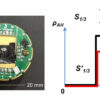As demands for computing resources continue to increase rapidly, scientists and engineers are looking for ways to build faster systems for processing information. One possible solution is to use patterns of electron spins, called spin waves, to transfer and process information much more rapidly than in conventional computers. So far, a major challenge has been in manipulating these ultrafast spin waves to do useful work.
In a significant leap forward, researchers from The University of Texas at Austin and MIT have developed a pioneering method to precisely manipulate these ultrafast spin waves using tailored light pulses. Their findings are detailed in two studies in Nature Physics, led by MIT graduate student Zhuquan Zhang, University of Texas at Austin postdoctoral researcher Frank Gao, MIT’s professor of chemistry Keith Nelson and UT Austin assistant professor of physics Edoardo Baldini.
A key component underlying our smartphones, the internet and cloud computing is magnetic data recording technology for storing and retrieving vast amounts of information. This technology hinges on the manipulation of the magnetic spin states (up and down) in ferromagnetic materials, representing the binary bits “0” and “1.” These spins are minuscule magnets, whose alignment determines the material’s magnetic properties.
When researchers strike one set of atoms in these materials with light, it causes their spins to wobble in a pattern that ripples out through neighboring atoms like waves on a pond when a stone falls in. This is a spin wave.
Unlike these conventional data storage materials, a special class of magnetic materials known as antiferromagnets feature spins aligned in opposite directions. Spin waves in these materials are typically much faster than their counterparts in ferromagnets and therefore hold potential for future architectures for high-speed information processing.
The researchers experimented with an antiferromagnet known as an orthoferrite. This material hosts a pair of distinct spin waves that usually do not talk to each other. By employing terahertz (THz) light, which is invisible to the human eye at extreme infrared frequencies, the researchers successfully made these spin waves interact.
In one paper, they showed that using intense THz fields to excite a spin wave at a certain frequency can initiate another spin wave at a higher frequency, somewhat like the harmonic overtones that naturally arise when a guitar string is plucked.
“This really surprised us,” Zhang said. “It meant that we could nonlinearly control the energy flow within these magnetic systems.”
In the other paper, they found that the excitation of two different spin waves can result in a new, hybrid spin wave. Baldini said this is particularly exciting because it could help push the technology from spintronics into a new realm called magnonics. In spintronics, information is carried in the spin of individual electrons. In magnonics, information is carried in spin waves (also known as magnons).
“Here, unlike with spintronics, you are using these collective type of spin waves that are involving many, many electron spins simultaneously,” Baldini said. “That can lead you to extremely fast timescales that are not reachable in spintronics and also move information in a more efficient way.”
To carry out this groundbreaking work, the researchers developed a sophisticated spectrometer to uncover the mutual coupling between distinct spin waves and to reveal their underlying symmetries.
“Unlike visible light that can be easily seen by the eye, THz light is challenging to detect,” said Gao. “These experiments would be otherwise impossible without the technique development, which allowed us to measure THz signals with only a single light pulse.”
More information:
Zhuquan Zhang et al, Terahertz-field-driven magnon upconversion in an antiferromagnet, Nature Physics (2024). DOI: 10.1038/s41567-023-02350-7
Zhuquan Zhang et al, Terahertz field-induced nonlinear coupling of two magnon modes in an antiferromagnet, Nature Physics (2024). DOI: 10.1038/s41567-024-02386-3
Provided by
University of Texas at Austin
Citation:
Researchers discover new ways to excite spin waves with extreme infrared light (2024, January 31)



